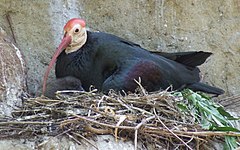Bald ibis
|
Geronticus Temporal range: Middle Miocene to recent 13–0 Ma |
|
|---|---|
 |
|
| Nesting southern bald ibis (G. calvus) with young. | |
| Scientific classification | |
| Kingdom: | Animalia |
| Phylum: | Chordata |
| Class: | Aves |
| Order: | Pelecaniformes |
| Family: | Threskiornithidae |
| Subfamily: | Threskionithinae |
| Genus: |
Geronticus Wagler, 1832 |
| Species | |
|
Geronticus calvus |
|
Geronticus calvus
Geronticus eremita
For fossil species, see text
The small bird genus Geronticus belongs to the ibis subfamily (Threskiornithinae). Its name is derived from the Greek gérontos (γέρωντος, "old man") in reference to the bald head of these dark-plumaged birds; in English they are called bald ibises.
Geronticus contains two living species. The northern bald ibis (G. eremita) has a neck crest of elongated feathers. It is a Critically Endangered species found around the Mediterranean. Its range had expanded after the last glacial period to the Alps of Germany and even a bit further north, but it was rendered extinct there mainly due to habitat destruction and unsustainable hunting. The southern bald ibis (G. calvus) with a red crown patch but no crest is classified as Vulnerable and is found in subtropical southern Africa.
Like most ibises, they are gregarious long-legged wading birds with long down-curved bills; they form one subfamily of the Threskiornithidae, the other subfamily being the spoonbills. The two Geronticus species differ from other ibises in that they have unfeathered faces and heads, breed on cliffs rather than in trees, and prefer arid habitats to the wetlands used by their relatives. Their food contains fewer aquatic animals and more terrestrial ones; they are known to gather together and feed on locust swarms, killing many of these notorious pests. This has also contributed to their decline however, as they were much affected by indiscriminate pesticide spraying in the mid-to-late 20th century, leading to their disappearance from many regions.
...
Wikipedia
